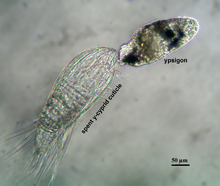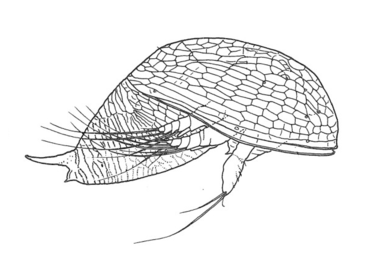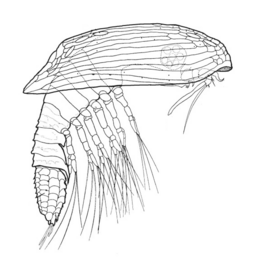Facetotecta
| Facetotecta | |
|---|---|

| |
| A Y-psigon escaping from its y-cyprid | |
| Scientific classification | |
| Domain: | Eukaryota |
| Kingdom: | Animalia |
| Phylum: | Arthropoda |
| Class: | Thecostraca |
| Subclass: | Facetotecta Grygier, 1985 |
| Family: | Hansenocarididae Itô, 1985 |
| Genus: | Hansenocaris Itô, 1985 |
| Species | |
|
See text | |
Facetotecta is a poorly known subclass of
neritic waters around Japan,[3] and the Mediterranean Basin, where they also survive in brackish water.[4]
History
The German zoologist
Cirripedia).[6]
Life cycle
-
Y-nauplius illustration
-
Y-cyprid illustration
Nauplius
Y-nauplii are 250–620 micrometres (0.010–0.024 in) long,
Cyprid
The presence of a distinctive
cyprid larva indicates that the Facetotecta is a member of the Thecostraca. A number of species have been described on the basis of a y-cyprid alone.[8] As in barnacles, the cyprid is adapted to seeking a place to settle as an adult. It has compound eyes, can walk using its antennae, and is capable of producing an adhesive glue.[9]
Juvenile
In 2008, a juvenile form was artificially produced by treating y-larvae with the hormone 20-hydroxyecdysone, which stimulated ecdysis and the transition to a new life phase. The resulting animal, named the ypsigon, was slug-like, apparently unsegmented, and limbless.[9][10]
Adults
While they have never been seen, the adult facetotectans may be
Species
Eleven species are currently recognised,[3] while one species which is assigned to Hansenocaris – H. hanseni (Steuer, 1905) – is of uncertain affinities:[5]
- Hansenocaris acutifrons Itô, 1985
- Hansenocaris corvinae Belmonte, 2005
- Hansenocaris furcifera Itô, 1989
- Hansenocaris itoi Kolbasov & Høeg, 2003
- Hansenocaris leucadea Belmonte, 2005
- Hansenocaris mediterranea Belmonte, 2005
- Hansenocaris pacifica Itô, 1985
- Hansenocaris papillata Kolbasov & Grygier, 2007
- Hansenocaris rostrata Itô, 1985
- Hansenocaris salentina Belmonte, 2005
- Hansenocaris tentaculata Itô, 1986
References
- ^
Chan, Benny K. K.; Dreyer, Niklas; Gale, Andy S.; Glenner, Henrik; et al. (2021). "The evolutionary diversity of barnacles, with an updated classification of fossil and living forms". Zoological Journal of the Linnean Society. 193 (3): 789–846. hdl:11250/2990967.
- ^ a b c d Joel W. Martin; George E. Davis (2001). An Updated Classification of the Recent Crustacea (PDF). Natural History Museum of Los Angeles County. p. 132. Archived from the original (PDF) on 2013-05-12. Retrieved 2009-12-14.
- ^ a b Daphne Cuvelier (April 4, 2005). "Hansenocaris Itô, 1985". World Register of Marine Species.
- S2CID 208372852.
- ^ S2CID 2943845.
- S2CID 84126659.
- ^ Christopher Taylor (February 23, 2008). "The secret of y-larvae". Catalogue of Organisms.
- Raffles Bulletin of Zoology. 55 (2): 343–353.
- ^ PMID 18598383.
- PMID 18492233.
- ^ Mark Grygier; Jens T. Høeg; Yoshihisa Fujita (July 2004). Introduction to the tremendous diversity of y-larvae (Crustacea: Maxillopoda: Thecostraca: Facetotecta) in inshore coral reef plankton at Sesoko Island, Okinawa, Japan (PDF). 10th International Coral Reef Symposium. Biodiversity and Diversification in the Indo-West Pacific. Okinawa, Japan. Archived from the original (PDF) on 2011-06-11.


